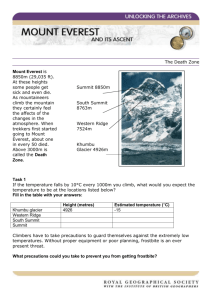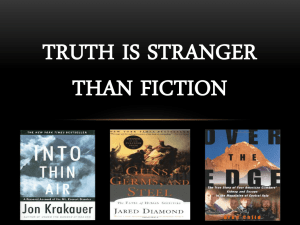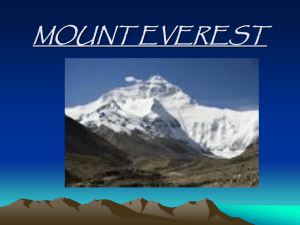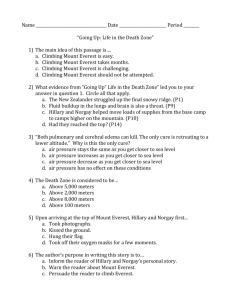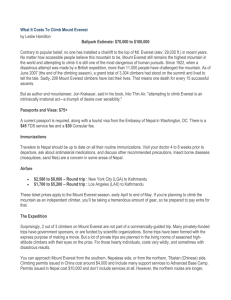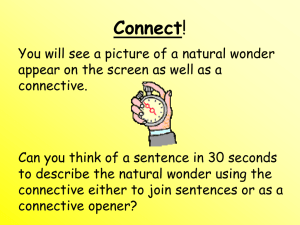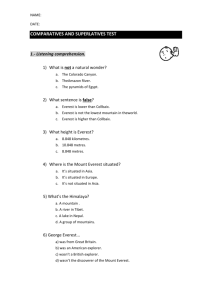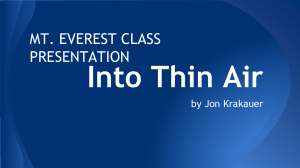Subject Complements(T)
advertisement
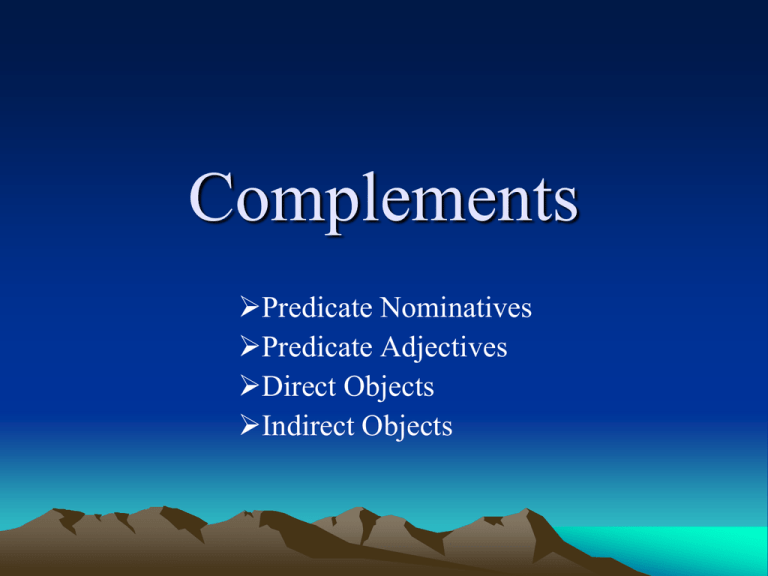
Complements Predicate Nominatives Predicate Adjectives Direct Objects Indirect Objects Definitions First … • Complements are words that complete the meaning or action of verbs. There are two general kinds: subject complements and objects of verbs. • A subject complement is a word that follows a linking verb and identifies or describes the subject. • A predicate adjective describes or modifies the subject. The climb had been difficult. The explorers felt extremely miserable. • A predicate nominative is a noun or pronoun. It identifies, renames, or defines its subject. Mount Everest was their goal. The trip became a nightmare. Why It Matters In Writing • Well-chosen predicate adjectives and predicate nominatives can help you create vivid descriptions and clear definitions. Notice: • “From the valleys of Nepal and Tibet, Mount Everest appears a stormy giant. Its soaring ridges look so powerful that observers feel humble. The mountain is at once beautiful and dreadful.” –Laura Chaveriat Let’s Practice … Directions: Underline predicate nominatives; circle predicate adjectives. 1. 2. 3. 4. 5. 6. 7. 8. Everest is the highest mountain in the world. Its slopes look risky, even to world-class climbers. Oxygen grows thin beyond the world’s base. Climbers often become immobile without extra oxygen. Frequently, frostbite becomes a real problem. Glaciers are great sources of danger. Their surfaces stay slippery because of the constant cold. Mount Everest remains a true test for most climbers. Let’s Practice … 1. 2. 3. 4. 5. 6. 7. 8. Everest is the highest mountain in the world. Its slopes look risky, even to world-class climbers. Oxygen grows thin beyond the world’s base. Climbers often become immobile without extra oxygen. Frequently, frostbite becomes a real problem. Glaciers are great sources of danger. Their surfaces stay slippery because of the constant cold. Mount Everest remains a true test for most climbers. Direct Objects • Action verbs often require complements called direct objects to complete their meaning. • A direct object is a word or a group of words that receives the action of an action verb. It answers the question what or whom. The climber caught. (Caught what or whom?) The climber caught the nylon rope. Let’s Practice … • The boy climbed the mountain. • The girl baked a cake for her mom. • The man gave roses to his girlfriend. • The small child ate a chocolate cookie. Let’s Practice … • The boy climbed the mountain. • The girl baked a cake for her mom. • The man gave roses to his girlfriend. • The small child ate a chocolate cookie. Indirect Objects • An indirect object tells to what, to whom, for what, or for whom an action is done. Verbs that often take indirect objects include bring, give, hand, lend, make, send, show, teach, tell, and write. The rescue team gives hot food (gives food to or for whom?) The rescue team gives the survivors hot food. Be Sure to Notice … • An indirect object will always come before a direct object, never after. It will NEVER follow a preposition (in which case it would become a prepositional phrase). The man gave his girlfriend roses. IO The man gave roses to his girlfriend. PP Let’s Practice … Directions: Underline direct objects; circle indirect objects. 1. 2. 3. 4. 5. 6. 7. 8. British surveyors calculated the height of Peak XV. In 1865 geographers gave Mount Everest its current name. Irvine lent Mallory a hand in their 1924 expedition. Unfortunately, a sudden ice storm overcame the explorers. In 1953, Hillary and Tenzig showed the world their talents. They conquered the summit of Mount Everest. On a 1996 expedition fierce blizzards killed eight climbers. Mount Everest still offers climbers a true challenge. Let’s Practice … 1. 2. 3. 4. 5. 6. 7. 8. British surveyors calculated the height of Peak XV. In 1865 geographers gave Mount Everest its current name. Irvine lent Mallory a hand in their 1924 expedition. Unfortunately, a sudden ice storm overcame the explorers. In 1953, Hillary and Tenzig showed the world their talents. They conquered the summit of Mount Everest. On a 1996 expedition fierce blizzards killed eight climbers. Mount Everest still offers climbers a true challenge. Sentence Patterns • We will be learning MANY different sentence patterns this year. This in one way of learning grammar, but more importantly, it is helpful in adding more sentence variety to your writing. First, we’ll start with the Basic Sentence Patterns … Basic Sentence Patterns S-V Mark ran. She sang. They talked. S-V-PP Mark ran to the corner. She sang at the concert. They talked until midnight. S-V-DO Jane wrote a letter. Cindy baked a cake. Peter drew a picture. S-V-IO-DO Jane wrote her friend a letter. Cindy baked her mom a cake. Peter drew his sister a picture. S-V-DO-PP Jane wrote a letter to her friend. Cindy baked a cake for her mom. Peter drew a picture for his sister. S-V-IO-DO-PP Jane wrote her friend a letter on Monday. Cindy baked her mom a cake for her birthday. Peter drew his sister a picture for Christmas. S-V-PN Mark is an athlete. That girl is a freshman. Mr. Autrey is the principal. S-V-PA Gina is thoughtful. John is tall. Those twins are identical.

